Scientists from Durham University, in collaboration with the University of Glasgow, both UK have developed a way to reveal the scale of atmosphere loss during planetary collisions based on 3-D supercomputer simulations. The simulations show how Earth-like planets with thin atmospheres may have advanced in an early solar system contingent upon how they are affected by different products.
The COSMA supercomputer was used in this study. Scientists ran over 100 detailed simulations of different giant impacts on Earth-like planets, altering the speed and angle of the impact on each occasion.
Scientists determined that such grazing impacts have very less atmospheric loss than a direct hit.
Head-on impacts and higher speeds prompted a lot more noteworthy erosion, some of the time crushing the atmosphere alongside a portion of the mantle, the layer that sits under a planet’s crust.
This study provides detailed insights on what happens during these giant impacts, which scientists know are popular and essential events in the evolution of planets both in our solar system and beyond.
Earth’s moon believed to be formed approximately 4.5 billion years ago following a collision between the early Earth and a giant impactor, possibly the size of Mars.
However, it was a mystery of how much of the Earth’s early atmosphere could have survived in this violent impact event, or how this would change for different collision scenarios.
The Earth was lucky that it survived collision—only losing between ten and 50 percent of its atmosphere, depending on the precise scenario.
Lead author Dr. Jacob Kegerreis, whose research was part-funded by a doctoral scholarship from the STFC, in the Institute for Computational Cosmology, at Durham University, said: “We know that planetary collisions can have a dramatic effect on a planet’s atmosphere, but this is the first time we’ve been able to study the wide varieties of these violent events in detail.”
“Despite the remarkably different consequences that can come from different impact angles and speeds, we’ve found a simple way to predict how much atmosphere would be lost.”
“This lays the groundwork to be able to predict the atmospheric erosion from any giant impact, which would feed into models of planet formation as a whole. This, in turn, will help us to understand both the Earth’s history as a habitable planet and the evolution of exoplanets around other stars.”
Co-author Dr. Vincent Eke, in the Institute for Computational Cosmology, Durham University, said: “At the moment it appears that the amount of atmosphere a planet loses due to these collisions depends upon how lucky or unlucky they are in terms the type of the impact they suffer.”
Fellow co-author Dr. Luis Teodoro, of the University of Glasgow, said: “Our research shows how different impacts can eject anywhere from very little to all of an atmosphere through a variety of mechanisms.”
Scientists are now conducting hundreds of more simulations to test the effects that the different masses and compositions of colliding objects might have.
The findings are published in the Astrophysical Journal.
